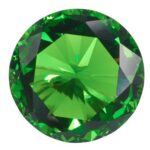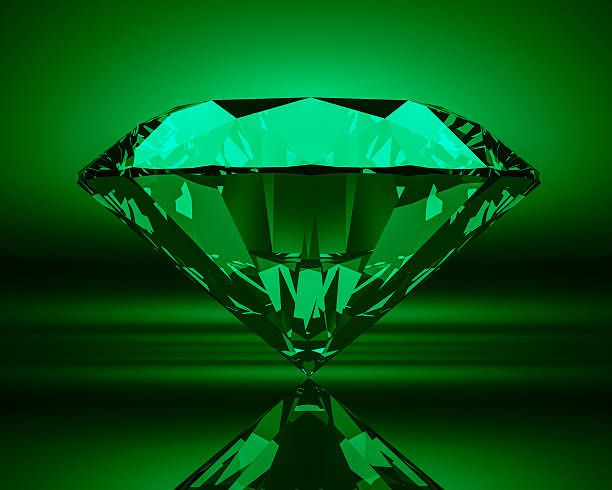Which is the Best?
emstones are among nature’s most mesmerizing creations, captivating humankind with their beauty, rarity, and powerful energies believed to positively influence our lives. With their diverse shapes, sizes, and colors, each gemstone offers its own unique charm and properties. This sheer variety, however, can make choosing the right gemstone a challenge, especially for those new to the world of gems.
Among all the gemstone colors, green has a special allure and significance, symbolizing renewal, growth, and vitality. Green gemstones in particular hold a unique appeal, attracting a fanbase of admirers for their vibrant, earthy hues and rich symbolism. This popularity also brings about an interesting comparison between two of the most admired green stones—green tourmaline and emerald. While both gems share similar color tones and are celebrated for their beauty and metaphysical value, they each have distinct qualities and attributes that set them apart.
Green tourmaline and emeralds are globally revered not only for their aesthetics but also for their significance in astrology and healing. Tourmaline is appreciated for its wide range of colors and is prized for its grounding energy, while emerald has held a sacred place in various cultures, symbolizing wisdom, balance, and clarity. Despite their shared green hue, these gemstones are unique in their composition, hardness, clarity, and cost, making it essential to understand the differences before making a choice.
In this guide, we’ll take an in-depth look at the qualities that distinguish green tourmaline from emerald, covering everything from their physical and optical properties to their respective benefits and ideal uses. By understanding these contrasts, you’ll be better equipped to choose the gemstone that best suits your personal or astrological needs. Dive in as we explore green tourmaline versus emerald, helping you make an informed decision on which of these stunning gems aligns with your aspirations and style.

Origins and Formation
Green tourmaline, part of the larger tourmaline family, is celebrated for its exceptional range of colors, with green shades often referred to as “Verdelite.” Found in places like Brazil, Africa, and the United States, green tourmaline gets its color from trace elements such as iron or chromium. Its formation involves high-temperature conditions, giving it a durability that makes it suitable for various types of jewelry.
Emerald, in contrast, belongs to the beryl family and derives its striking green from chromium and vanadium. Known as one of the oldest gemstones, emeralds are mined in Colombia, Brazil, and Zambia. With a softer structure compared to tourmaline, emeralds are often found with natural inclusions or “jardin,” which are tiny fractures and impurities that add to the stone’s unique character and value.
Physical Properties: Hardness and Durability
One major difference between green tourmaline and emerald is their durability. Green tourmaline scores a 7 to 7.5 on the Mohs scale, making it quite durable for jewelry. Emeralds, on the other hand, rate slightly lower on the Mohs scale at around 7.5 to 8 but are often more prone to fractures due to inclusions, requiring greater care in handling and setting.
For those looking for a daily-wear gemstone, green tourmaline may be more practical due to its robustness and lower likelihood of chipping, while emerald’s unique visual characteristics make it ideal for occasional wear or as a centerpiece in jewelry designs.
Optical Properties: Color and Clarity
Both green tourmaline and emerald come in captivating green shades, but they differ in tone and vibrancy. Green tourmaline typically exhibits a wide spectrum of green, from mint green to deep forest green. The color can vary depending on the amount of iron or chromium, and the stone often shows a slightly brighter appearance.
Emeralds, known for their rich, deep green color, display a more saturated hue due to chromium and vanadium. High-quality emeralds exhibit a vibrant, velvety green, often with an intense depth and uniformity that many gem enthusiasts find unmatched. In terms of clarity, emeralds generally have more inclusions, which are accepted as part of the gem’s identity, while green tourmalines tend to have fewer inclusions, allowing for greater clarity and brightness.
Astrological and Healing Benefits
Both gemstones hold a place of esteem in astrology and are thought to offer a variety of metaphysical benefits. Green tourmaline is associated with the heart chakra, promoting emotional healing, compassion, and self-confidence. It’s also believed to ground energy, enhance prosperity, and provide mental clarity, making it a popular choice for those seeking personal growth and balance.
Emeralds, traditionally linked to the planet Mercury, are thought to bring wisdom, insight, and calmness. Known as the “Stone of Successful Love,” emeralds are said to encourage harmony in relationships, support mental clarity, and boost creativity. In Vedic astrology, emeralds are often recommended for those seeking to improve communication skills, intellectual growth, and peace of mind.
Value and Rarity
In terms of price, emeralds are generally more valuable than green tourmaline due to their rarity and historical significance. Fine-quality emeralds, particularly those with rich color and fewer inclusions, can command high prices, especially if they originate from renowned mining regions such as Colombia. Green tourmaline, while also valued, is more accessible and offers a cost-effective alternative for those who want a beautiful green gemstone without the high cost of emeralds.
Choosing Between Green Tourmaline and Emerald
When deciding between green tourmaline and emerald, consider both your aesthetic preferences and practical needs. If you seek a gemstone that can withstand daily wear with minimal maintenance, green tourmaline might be the better choice. Its durability and range of green tones make it versatile and suitable for various styles.
However, if you’re drawn to a gemstone with historical significance, rich color, and a touch of elegance, an emerald could be the ideal option. Despite requiring extra care, the timeless beauty and symbolic meaning of emerald make it an exceptional choice for special pieces.
Final Thoughts
Both green tourmaline and emerald have unique qualities that make them special in their own right. Whether you’re looking for emotional healing, an eye-catching piece of jewelry, or a stone with profound astrological meaning, these gems offer beauty and benefits in abundance. We hope this comparison has brought you closer to finding the green gemstone that resonates with your style and aspirations.











